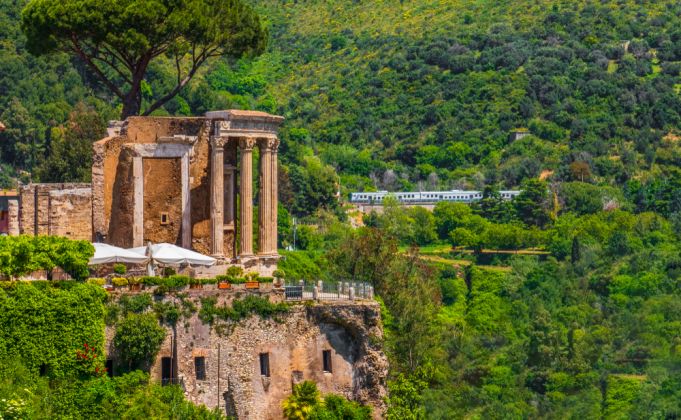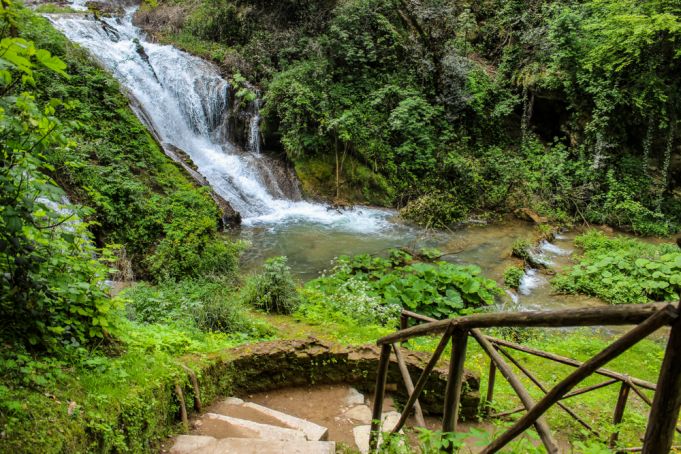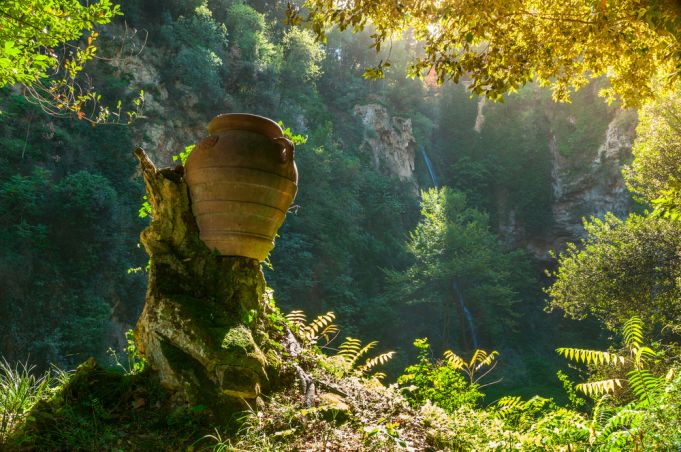Villa Gregoriana in Tivoli makes for a great day trip from Rome.
Not many people realise that in the 19th century, Tivoli had a visitor attraction that surpassed Hadrian’s Villa and Villa d’Este.
But when artists, poets and writers of the Romantic era visited the town during the Grand Tour, the first place they wanted to see was another garden – a garden carved out of a chasm that ran down the side of the Great Cascade of the Aniene river.
The Villa Gregoriana was created by Pope Gregory XVI in 1832 as a public park and had all the requisites of the ideal Romantic environment.
It was a wilderness garden, plunging steeply down into a ravine, filled with secret grottoes, old Roman ruins, thick Mediterranean vegetation, pools and frothing cataracts, dominated by the sound of the crashing waters of the 120m-high waterfall.
Forgotten treasure
Throughout the 20th century, however, this treasure was largely forgotten. The area suffered bomb damage during the last war and was totally abandoned.
In 2002, the park was taken over by the Fondo Ambiente Italiano (FAI), an organisation similar to the British National Trust. It was in such a bad state that it required a mammoth landscape recovery operation.

Where to find Villa Gregoriana
To reach the Villa Gregoriana, you go through Tivoli, past the mediaeval fortress and along the riverside.
The villa is just beyond the hydro-electric dam, on the fringe of the most interesting and picturesque part of the town, with winding mediaeval streets, archways, artisan workshops and the two celebrated Roman temples (prominently featured in Tivoli tourist brochures) crowning the rock of the ancient acropolis – one believed to be dedicated to Tibertus, the town’s mythical founder, and the other to Albunea, the Sybil Tiburtina, credited with prophesying the birth of Christ.
The temples stand directly above the garden, and the destiny of the three are linked. Originally, the Aniene river plunged out of Neptune’s Grotto, a fissure in the rocks directly beneath the temples, causing havoc in the plain below whenever the river burst its banks.
On 17 November 1826 a bad flood destroyed much of the town and the ruling Pope Pius VIII decided that something had to be done.
A daring solution was eventually proposed by Italian architect Clemente Folchi, who altered the course of the river, channelling it into twin 280m-long tunnels dug through the nearby Mt Catullo.
Pius’ successor, Gregorio XVI, presided over the lavish inauguration ceremony, which featured a spectacular display of fireworks issuing like flames from the tunnels’ mouths. Later, the project became part of a hydro-electric system that made Tivoli the first Italian town to have electric lights.

You have to be fairly fit to descend into the depths of the park, and comfortable, non-slip shoes are a must. It is all flights of steep stone steps, uneven ground and twists and turns. However, the experience is worth the slog. Panoramic terraces give onto spectacular views.
You pass places of interest, such as the ruins of the first-century Roman Villa of Manlio Volpiscus, described in rapturous terms by Roman writers Horace and Statius. Walk through the spooky Percorso Moillis, a passage cut through the side of the rock in 1809 to give artists and other visitors easier access to the chasm. Hitherto, they had had to be lowered down on ropes.
Mermaid's Cave
These days, paths run right down to the bottom, known as the “Valley of Hell” and traversed by a series of pools and rivulets, fed by the waterfall crashing down from above.
The hauntingly beautiful “Mermaids’ Cave”, so-named by French artist Louis Ducros, channels the water into a crystal-clear rock pool and then off into further unseen depths.
By the time you have finished the hour and a half tour, you’ll be glad of some kind of refreshment, which you can have either at the FAI-run bar beside the Tibertus Temple or at the adjacent Michelin-starred Sibilla restaurant, which is one of the oldest restaurants in the world and a site in its own right.

The walls are covered with marble plaques commemorating the visits of the crowned heads of Europe and other eminent guests. To mention just a few: Charles and Elizabeth, Prince and Princess of Prussia came with Princess Margherita of Savoy in 1877, the Queen of Sweden was here in 1918, the Infante of Spain dined in 1969, Princess Margaret of Britain (the present queen’s late sister) in 1965, and in 1999 Duchess Zelda Marzec, Grand Dame of the Order of Malta, celebrated her birthday here.
The restaurant has belonged to the La Caita-Frittella family since 1980. The present generation are keen on promoting local produce and regional specialities and offer a choice of set lunch menus, very reasonably priced.
By Margaret Stenhouse
This article was originally published in the October 2011 edition of Wanted in Rome magazine.
Visiting Villa Gregoriana
Parco Villa Gregoriana, Tivoli, tel. (0039) 0774332650, e-mail: faigregoriana@fondoambiente.it
Visitors are advised to wear shoes with rubber soles for the tour, since the paths are uneven at a number of points, and the rocks and steps can be slippery.
Opening hours
March, open Tues-Sun 10.00-17.00.
April to June, open daily 10.00-18.30.
July-August, open daily 10.00-20.00.
1-15 October, open daily 10.00-18.30.
16-22 October, daily 10.00-18.00.
23-31 October, daily 10.00-16.00.
1 November-17 December, open Tues-Sun 10.00-16.00.
Last entry: an hour before the Park closes in the evening.
Open all public holidays that fall on a Monday.
How to get there
By car from Rome: Take the Tivoli or Castel Madama exits from the Roma-L'Aquila A24 motorway and follow the signs for Tivoli, Villa Gregoriana.
By train from Rome: leave from Tiburtina Station and get off at Tivoli.
By coach from Rome: leave from Ponte Mammolo or Tiburtina Station and get off at Tivoli.
Tickets
Adults: €7
Families: €17
Children (4-14 years): €3
Reduced ticket for students and residents in Tivoli: €2.50
Students aged up to 26: €4
Children under 3 are free.
FAI and National Trust members: free entrance
For full visiting details see FAI website or Visit Tivoli website.
General Info
View on Map
Villa Gregoriana: Tivoli's wilderness garden
Largo Sant'Angelo, 1, 00019 Tivoli RM, Italy


















